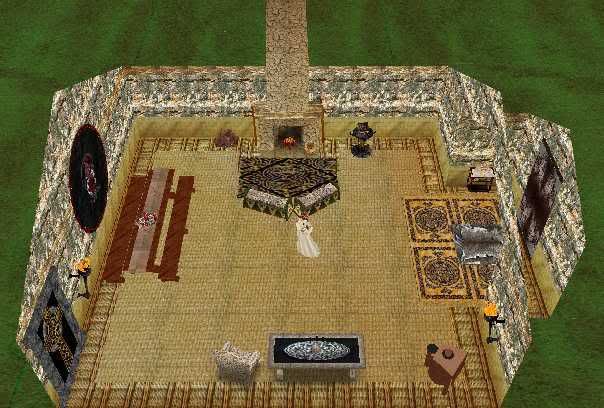 Until the 19th century, the idea of Viking settlement in North America was considered by historians to be the product of mere folk tales. The first scholarly theory for the idea was put forth in 1837 by Danish literary historian and antiquarian Carl Christian Rafn in his book Antiquitates AmericanŠ. Rafn had made an exhaustive examination of the sagas, as well as potential settlement sites on the North American coast and concluded that Vinland was a real place in North America that had been settled by the Norse.
However, when the Vikings settled, they did not have good relationships with the aboriginal people. The Vikings raided nearby villages and killed whoever failed to escape into the woods, but despite hostilities, furs, cloth and other goods were traded between the Vikings and aboriginals. When war was finally settled, the Vikings built houses (similar to the ones in Greenland) out of sod (turf) with clay floors, since the sod provided good insulation and stopped rainwater going into the home.
The Vikings caught fish, hunted game animals, picked berries, and had brought meat, cattle, and poultry from Iceland. The cattle not only provided food, but some also produced milk (and eventually dairy products). The chickens not only provided meat but also eggs, and their chicks maintained the poultry system. (Vinland
From Wikipedia, the free encyclopedia)
Until the 19th century, the idea of Viking settlement in North America was considered by historians to be the product of mere folk tales. The first scholarly theory for the idea was put forth in 1837 by Danish literary historian and antiquarian Carl Christian Rafn in his book Antiquitates AmericanŠ. Rafn had made an exhaustive examination of the sagas, as well as potential settlement sites on the North American coast and concluded that Vinland was a real place in North America that had been settled by the Norse.
However, when the Vikings settled, they did not have good relationships with the aboriginal people. The Vikings raided nearby villages and killed whoever failed to escape into the woods, but despite hostilities, furs, cloth and other goods were traded between the Vikings and aboriginals. When war was finally settled, the Vikings built houses (similar to the ones in Greenland) out of sod (turf) with clay floors, since the sod provided good insulation and stopped rainwater going into the home.
The Vikings caught fish, hunted game animals, picked berries, and had brought meat, cattle, and poultry from Iceland. The cattle not only provided food, but some also produced milk (and eventually dairy products). The chickens not only provided meat but also eggs, and their chicks maintained the poultry system. (Vinland
From Wikipedia, the free encyclopedia) Until the 19th century, the idea of Viking settlement in North America was considered by historians to be the product of mere folk tales. The first scholarly theory for the idea was put forth in 1837 by Danish literary historian and antiquarian Carl Christian Rafn in his book Antiquitates AmericanŠ. Rafn had made an exhaustive examination of the sagas, as well as potential settlement sites on the North American coast and concluded that Vinland was a real place in North America that had been settled by the Norse.
However, when the Vikings settled, they did not have good relationships with the aboriginal people. The Vikings raided nearby villages and killed whoever failed to escape into the woods, but despite hostilities, furs, cloth and other goods were traded between the Vikings and aboriginals. When war was finally settled, the Vikings built houses (similar to the ones in Greenland) out of sod (turf) with clay floors, since the sod provided good insulation and stopped rainwater going into the home.
The Vikings caught fish, hunted game animals, picked berries, and had brought meat, cattle, and poultry from Iceland. The cattle not only provided food, but some also produced milk (and eventually dairy products). The chickens not only provided meat but also eggs, and their chicks maintained the poultry system. (Vinland
From Wikipedia, the free encyclopedia)
Until the 19th century, the idea of Viking settlement in North America was considered by historians to be the product of mere folk tales. The first scholarly theory for the idea was put forth in 1837 by Danish literary historian and antiquarian Carl Christian Rafn in his book Antiquitates AmericanŠ. Rafn had made an exhaustive examination of the sagas, as well as potential settlement sites on the North American coast and concluded that Vinland was a real place in North America that had been settled by the Norse.
However, when the Vikings settled, they did not have good relationships with the aboriginal people. The Vikings raided nearby villages and killed whoever failed to escape into the woods, but despite hostilities, furs, cloth and other goods were traded between the Vikings and aboriginals. When war was finally settled, the Vikings built houses (similar to the ones in Greenland) out of sod (turf) with clay floors, since the sod provided good insulation and stopped rainwater going into the home.
The Vikings caught fish, hunted game animals, picked berries, and had brought meat, cattle, and poultry from Iceland. The cattle not only provided food, but some also produced milk (and eventually dairy products). The chickens not only provided meat but also eggs, and their chicks maintained the poultry system. (Vinland
From Wikipedia, the free encyclopedia)